I was introduced sit spots when I did the Wild Deer program with the Pine Project in 2015. I’ve never really made it a daily practice, but maybe in tiny ways I do. I did this Sit Spot fundraiser, my second one, to challenge myself to sit longer and as a way to mark the solstice, always with so much gratitude that Pine is helping kids and adults “open their eyes” to the rich and amazing world that is around us all the time.
Summer solstice, 2021. The elderberries are flowering. The wild strawberries and service berries are ripe. The forest is loud with the sound of gypsy moth caterpillars munching leaves and picnic tables under trees are covered in the tiny black pellets of their faeces. I’m glad to pause from my frenetic gardening to do the 4 hour sit spot. In the early morning I meet a friend to do breeding bird atlassing at Plan B organic farm, a place I work and my children’s home with their father. Then I spend “the morning” (9-5… I’m not good at stopping with the plants) at Planting Seeds of Hope, tending land that is dedicated to children and supporting their connection to the natural world. The most special planting I do is planting three wafer ash trees, a native medicinal tree I am very excited about.
I’m ready to start my sit spot but my 12 year old calls and needs me to help with animal care. So instead of doing sit spot at Planting Seeds of Hope I head to Plan B to do my sit in the backyard of a home I lived in for many years, a home I visit every week.
I begin by watching a young red squirrel in the black walnut trees. It spends about ten minutes eating one black walnut. Eventually it drops the shell, runs out on a thin branch and gives a chirring call. Soon after an older red squirrel comes from the cedar stand just to the north and seems to be defending its territory. The younger one runs west along more black walnuts to the side of the house and flattens itself on a branch. It looks submissive. A few moments later it runs along.
I sit in the grass I know to be full of ticks and mosquitos buzz. I see a yellow bird in tall grass – likely getting food – an insect? It flies back along the tree line towards the yellow warbler nest I was told about in the morning.
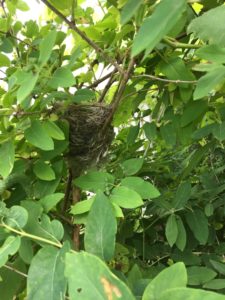
No one else is at the farm except for the dogs who come find me. Not wanting to get licked gets me up off the ground. I wander 20 feet south down the tree line and find the nest. A peek inside. An awesome glance at a tiny naked baby mouth open hoping for food. Likely its first day of life as my friend saw it as an egg the day before. I quickly move back 10 paces and settle to watch. I sit there for the next hour on the thin mowed path between tree line and greenhouse, watching the parents come and go from the nest every few minutes. It takes a while to be certain 2 parents are working together. I’m just meeting this species – the first warblers I’m getting to know. The male has gorgeous reddish streaks striped down his chest. The parents weave through the scrubby growth to get to the nest – taking different routes each time. Parents and baby are quiet. Robins are around being loud – I watch more than one eat a fat gypsy moth caterpillar.
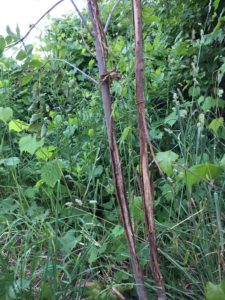
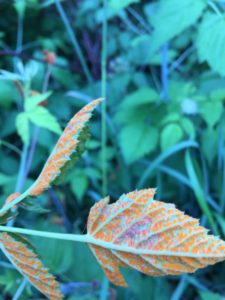 The hedgerow has lots of black cap raspberries – it will be a delicious place to return to in a few weeks. One young plant’s leaves are covered in a bright orange rust fungus. I realize there are trails through the hedgerow made by the dogs and recognize that the resident farm kids know all about that. There is a young white ash tree that has shredded bark. I’ve watched squirrels do that to linden and basswood – trees I don’t know to be at this site. Later I read about yellow warblers using bark fibre in their nests and wonder if some of that ash was in the tiny cup nestled in the honeysuckle bush about 4 feet off the ground. That ash also has a number of leaves curled in a way I’ve learned means a caterpillar has likely cocooned within. I wonder who.
The hedgerow has lots of black cap raspberries – it will be a delicious place to return to in a few weeks. One young plant’s leaves are covered in a bright orange rust fungus. I realize there are trails through the hedgerow made by the dogs and recognize that the resident farm kids know all about that. There is a young white ash tree that has shredded bark. I’ve watched squirrels do that to linden and basswood – trees I don’t know to be at this site. Later I read about yellow warblers using bark fibre in their nests and wonder if some of that ash was in the tiny cup nestled in the honeysuckle bush about 4 feet off the ground. That ash also has a number of leaves curled in a way I’ve learned means a caterpillar has likely cocooned within. I wonder who.
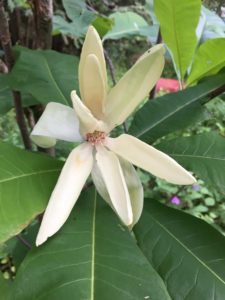
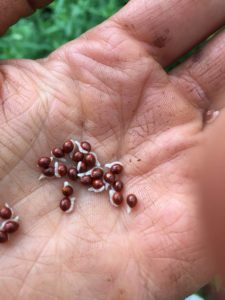
I wander about 30 feet north into the cedar grove where the elder red squirrel seemed to be. I like to check on a cucumber magnolia I know is planted there. It is blooming. The bloodroot seeds are ripe, shiny bronze with the sparkly white foamy elaiosome that attracts the ants who disperse the seeds. And then I notice a tree I did not know was there. A wafer ash sapling! As tall as me. And another. And then some with ripening seeds. I count 13 of them and then find the mother tree. I’ve never found this tree in the wild. It sure helped that I was looking at the same leaf pattern earlier in the day. The mother tree was surely planted by the same native tree lover who put in the cucumber magnolia – and they have naturalized! Maybe the baby wafer ashes I planted will struggle in the full sun I gave them – they love the deep shade between a tulip tree, many cedars and a few black walnuts.
What a joy to make time to discover yellow warblers and mature wafer ash. To add a little knowing so I can understand a tiny bit more of the patterns around me.
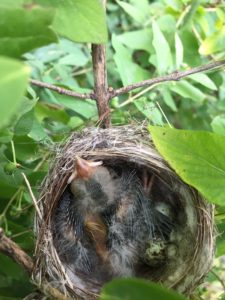
I’m so grateful I did this sit in a place I, and my children, go to all the time. In the week since I’ve gone back to check on the yellow warbler nest a number of times. A week later the chick is bigger than the parents – I’m guessing it is a brown cowbird. They lay their eggs in yellow warbler nests and get them to do the work! I peaked underneath the baby and can see 4 or 5 more eggs – are they of the yellow warblers? There is no room in that nest for any other babies! I brought my son to see the nest and he found it awesome.
Thanks so much to everyone of you who donated towards this fundraiser to help kids know the diversity of life that we are all a part of yet so disconnected from. To help open and teach eyes and ears so we can be enriched by what is all around us.